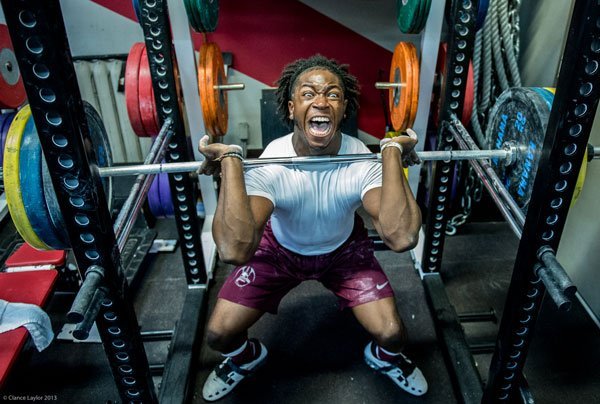
Think about the coaching tips you get every time you lace up your skates, put on your cleats, pick up your bat, step onto the track, jump into the pool, or wherever you go to dominate the opposition. Whether you’re crashing the net or crashing the boards for a rebound, you need to crash and bang, and your coach reminds you every game and every practice that you have to be STRONG. Strong on the ball, strong in the corners, strong in the paint. Being stronger than the person in front of you is the key to getting the extra yard for a first down, the extra inches to snatch a home run away, the extra drive to get to the finish line first. We’re going to talk about how strength is the foundation for success in every sport: from power lifting to golf, increasing your strength will translate into gains when it’s time to perform.
Strength is simple: it’s the amount of force that you can produce. When you break it down, Newton’s second law of motion teaches us that force is created when you accelerate a mass (Force = Mass x Acceleration (F=ma)). Strength is all about the force your muscles can produce, creating movement. When your muscles produce enough force, they allow you to accelerate (a) your body mass (m), or if you’re a big defenceman, you can accelerate the body mass of some poor forward with his head down. Although, that’s getting into high-load speed strength; we’ll talk about that a little later.
Force production is the foundation of all movement, and even chess players (they’re athletes too, right?) need to produce enough force to move the pieces around the board. Let’s look at that formula one more time: F=ma. If we can train our muscles to be strong enough to produce a certain maximum force in a given athletic situation, that means one of two things: we can move our bodies or an external object of a similar mass faster than before, or we can accelerate our bodies or something heavier than our bodies. In plain old English, this means you can run, skate, start, stop, change direction faster than your opponent; you can stiff arm a linebacker, box out a center for a rebound, or knock out a boxer who might be heavier than you; you can throw a baseball harder, shot put farther, jump higher, and generally perform better than you could before.
For those of you who are more experienced with weight training, you’re probably thinking “many of those qualities are affected by different training stimuli,” and you’re definitely right. Explosive Strength (power) and Reactive Strength (plyometrics) are used to fine tune your neuromuscular abilities by focusing the Maximum Strength that you have just built.
Explosive Strength focuses on increasing the Rate of Force Development (RFD), or how fast your muscles are able to produce force. This type of strength is especially important for power lifting, Olympic lifting, shot put, weight throw, baseball pitchers, javelin, and discus, as these sports are expressions of maximal explosiveness. If you can create the same maximal force that you have developed through your Maximal Strength phase faster, this will translate into performance. This is expressed through high-load speed strength (moving heavier loads, like a snatch) and low-load speed strength (moving your body weight, or lighter loads such as in discus).
Reactive Strength qualities are beneficial to athletes who are dynamic in their sport. This applies to most team sports and individual sports, including hockey, rugby, football, baseball, golf, tennis, squash, etc. Reactive Strength is the muscle’s ability to apply force quickly, after completing a Stretch Shortening Cycle (SSC). The SSC is the transition from, yep… you guessed it: being stretched, to being shortened. If you’re a soccer player running one direction and the ball zips by to your left, you want to get there as quickly as possible. Instead of stopping, turning left, and starting to run, we simply crossover and push off with our right foot, propelling our body to the left. We don’t do a full squat and jump to the left. We plant and push off, wasting no time at all. And if your SSC is faster and produces greater force than the defender, I think we can figure out who gets to the ball first.
Whatever your sport is, strength training is the foundation for success. It doesn’t take the place of practicing your sport, but if you are trying out for the pros and you’re weak I can guarantee it won’t matter how fancy your footwork is when you’re on your ass and the other guy has the puck.
References
Hales, M (2011) Evaluating Common Weight Training Concepts Associated With Developing Muscular Strength: Truths or Myths? Strength and Conditioning Journal; February; 33 (1); pp. 91- 95.
Hori, N; Newton, R; Nosaka, K; Stone, M (2005). Weightlifting Exercises Enhance Athletic Performance That Requires High-Load Speed Strength. Strength and Conditioning Journal; August; 24 (4); pp. 50 – 55.
Leave A Comment